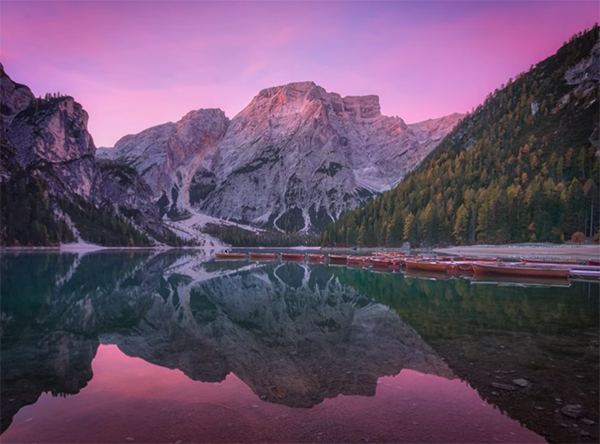Looking for a Meaco Arete dehumidifier? This is where you can find them in stock
Move fast – the highly rated Meaco Arete dehumidifier is selling out quickly
If landscape photography is a primary areas of interest, you’re likely familiar with the conventional “wisdom” that f/11 is the optimum aperture to use when shooting this genre of imagery. But many accomplished pros consider this “rule” nothing more than a useless myth, and the tutorial below explains why.
Instructor Mark Denney is a very successful outdoor photographer with a unique combination of skills. That’s because he’s equally adept behind the computer as he is with a camera in his hands. In this enlightening episode he shares three reasons why the f/11 approach is a rule “you should avoid at all costs.”
Denney backs up this opinion by revealing what he’s found to be a much better solution when it comes to determining the best camera settings to use in various situations. According to the so-called rule, f/11 is generally the best aperture for achieving front-to-back sharpness throughout the entire frame—no matter the camera and lens you use, and the specifics of the scene at hand.

Denney says the main reason to be more circumspect about selecting an f/stop is this: “There are three key variables to consider that all debunk this f/11 myth.” At the top of his list is the fact that sensor size and focal length “matter a lot.” Think of it this way: an aperture of f/11 on a micro-four-thirds camera is different from the same setting on an APS-C sensor. Likewise, f/11 on an APS-C camera provides different results than that aperture when shooting full-frame.
The video includes several great examples of why and how this works. As you’ll see, Denney’s stunning images were shot using cameras with sensors of different sizes, and none of them were shot at f/11. Bottom line: The size of the sensor will completely change the effect of various aperture values.
Other important considerations include the performance of the specific lens in use, and Denney explains how to find the “sweet spot” of every lens you own. He also explains how the elements in a scene factor into the equation when choosing the best f/stop for the task at hand.

With these explanations out of the way, Denney spends the last four minutes of the episode explaining his “better solution” for shooting the best possible landscape photos. Once you’re done watching head over to his popular YouTube channel where you’ll find a wealth of information for improving your landscape photography skills.
On a related note, we also suggest checking out the recent tutorial we posted from another accomplished landscape shooter, explaining the proper way to use HDR editing for realistic-looking outdoor photos with maximum impact.
Have you ever photographed an amazing subject and did a great job of composition, only to discover that the image is far less compelling than you had hoped? Well, join the club. There are several potential reasons for your shot missing the mark, and today’s Photoshop tutorial demonstrates why you should consider enhancing the image to unleash its full potential, rather dumping it in the trash.
Maybe you captured the photo under flat, dull lighting conditions, or you didn’t quite nail focus. Or perhaps you used the wrong camera settings for the specific task at hand. Whatever the cause, Instructor Nemanja Sekulic demonstrates a straightforward editing technique for achieving the drama your scene deserved.
Sekulic describes himself as a photographer and digital artist with “a child-like ability to be amazed by creative photo manipulation”—a powerful attribute we should all be willing to embrace. In today’s 13-minute he demonstrates his favorite workflow for transforming a ho-hum photo into one that really demands attention.

Starting with a Raw file provides the best opportunity for harnessing the power of this easy method. In this case, however, Sekulic is working with a Jpeg file and he still delivers the goods. He provides a link for downloading the image in the description beneath the video so you make the changes yourself as they’re explained.
Sekulic converts the image into a Smart Object (after making a copy for safekeeping), using a helpful keyboard shortcut to speed things up. He then applies a Camera Raw filter to expand the dynamic range. Next he employs simple sliders to drop exposure, highlights and blacks, while increasing contrast, and whites. The noticeable result of these basic adjustments is just the starting point for everything that follows.
Now Sekulic selects a soft brush with 50% opacity to dodge and burn the background and add a nice vignette. These quick enhancements effectively separate his main subject, a wolf, from the rest of the scene. After slightly desaturating the background he adds what he calls “human saturation” to the calm-looking wolf.

At this point the image is significantly improved, but you’re less than halfway through the transformation. What follows include Luminosity Blending, a bit of shading, and a few adjustments that significantly add much-needed detail to the wolf’s face, eyes, and fur. He further modifies saturation to finish the job. The before/after images are a testament to the effectiveness of this simple method.
After watching the video pay a visit to Sekulic’s instructional YouTube channel where you’ll pick up more post-processing tips and tricks.
We also suggest watching a tutorial we posted recently from another expert, explaining a unique way to sharpen outdoor photographs without the drawbacks of a standard approach.
